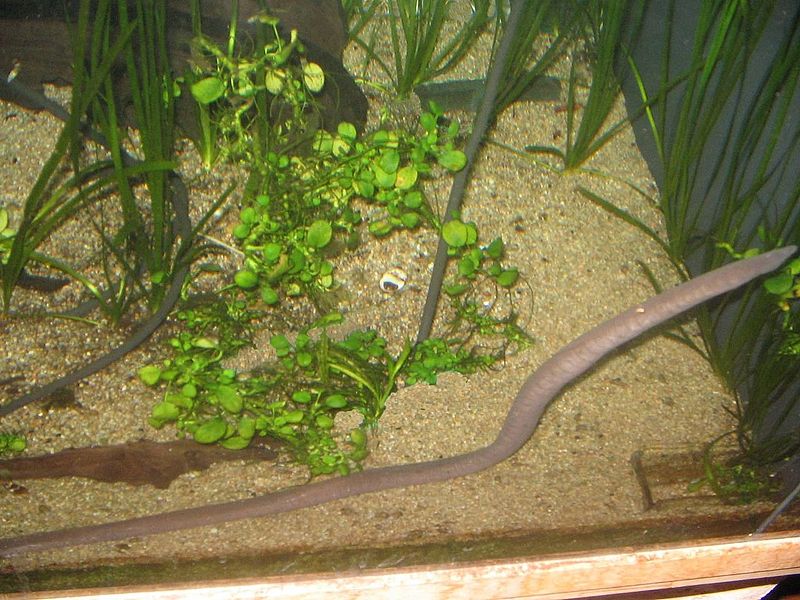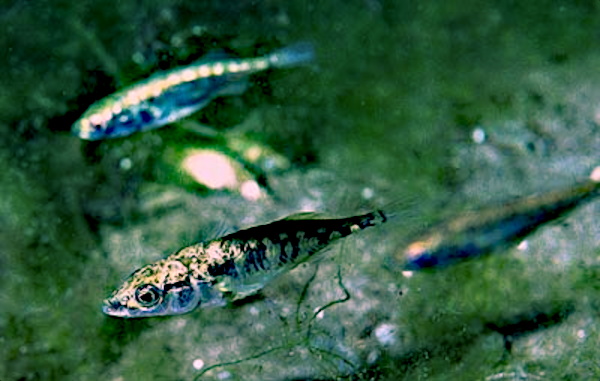Hey Fish Blog Followers! There are lots of different types of freshwater communities created by hobbyists. Some people choose a peaceful community of tetras and other small docile fish, while others opt for a tank populated with predators or other territorial species, often a fine balance between tolerance and aggression. Many aquariums are somewhere in between, referred to as semi-aggressive communities, which often include fish such as barbs, gouramis, large tetras and others that fit into the category. Today I wanted to give a small introduction to several popular species of fish often purchased for these aquariums that may interest you.
Not Exactly Maneaters
Some of the most popular fish for the freshwater semi-aggressive community are the cyprinids known as sharks. These are not the cartilaginous carnivores as featured in movies or the Discovery Channel. These fish are found primarily in the waters of Southeast Asia and Thailand. There are several species that are often imported for use in the aquarium trade, and several species also referred to as sharks that are less common in the trade. Though from several different genera, these fish all have in common the pointed heads and large, curved dorsal fins that give them their misleading common names.
Though these fish lack teeth, as a general rule they are considered semi-aggressive, if not for the sizes they attain, then for the  territoriality they often express as they mature. They are generally not suitable for tanks under 55 gallons (some not less than a 75 to 100 gallon tank) and should only be mixed with fish that can stand up to the potential for chasing and harassment that sharks can dish out (especially to their own kind). Smaller fish may eventually be seen as a snack as the fish grow. Sharks make bold and interesting additions to freshwater semi-aggressive communities, as long as the tank is of adequate size and the conditions in the tank suit their needs. Suitable tank mates for most include fish like barbs, catfish, large tetras, and other fish of similar temperament.
territoriality they often express as they mature. They are generally not suitable for tanks under 55 gallons (some not less than a 75 to 100 gallon tank) and should only be mixed with fish that can stand up to the potential for chasing and harassment that sharks can dish out (especially to their own kind). Smaller fish may eventually be seen as a snack as the fish grow. Sharks make bold and interesting additions to freshwater semi-aggressive communities, as long as the tank is of adequate size and the conditions in the tank suit their needs. Suitable tank mates for most include fish like barbs, catfish, large tetras, and other fish of similar temperament.
If you are considering the addition of a shark to your community, there are several things to keep in mind. As far as the set-up goes (besides having an adequately sized aquarium) be sure that you provide plenty of cover like wood, plants or rock formations so these fish can hide and fell secure when they feel the need. A tightly fitting lid is also highly recommended as they tend to be terrific jumpers, especially if startled. Most common sharks prefer well-aerated, clean water with temps between 74 and 81 degrees (F) and a pH maintained between 6.5 and 7.5. Sharks do not tend to be finicky eaters, readily accepting flakes, pellets and frozen, freeze-dried or live treats like bloodworms, tubiflex, glass worms, plankton, brine shrimp or other meaty tidbits.
Popular Species
There are several species of freshwater shark, and variants of these species, regularly available on the market that may be candidates for your semi-aggressive community.
Bala Sharks (Balantiocheilus melanopterus), also called Tricolor Sharks, are a popular variety with silvery scales and bold black edges on the fins and tail. Though attractive, this species tends to be rather skittish unless kept in small groups. These fish tend to be more shy and docile than many of the other sharks. Reaching a length of between 13 and 15 inches potentially, this species is best left to aquarists with tanks of at least 75 gallons or more for a single specimen, much larger if they are to be kept in the security of a small group.
this species tends to be rather skittish unless kept in small groups. These fish tend to be more shy and docile than many of the other sharks. Reaching a length of between 13 and 15 inches potentially, this species is best left to aquarists with tanks of at least 75 gallons or more for a single specimen, much larger if they are to be kept in the security of a small group.
Rainbow Sharks (Epalzeorhynchos frenatus) may be the best choice for most hobbyists, despite their tendency to become territorial and increasingly aggressive as they mature. Also known as the Ruby Shark or the Red-Finned Shark, this species grows to only about 6 inches and bears bright red fins that are quite attractive. Several variants have also been selectively bred to make things even more interesting, such as albinos and white-finned. These sharks should be kept as a single specimen in the community as they do not tend to tolerate others of their kind in the confines of an aquarium. Red-tail Sharks (Labeo bicolor) are similar in size and behavior to Rainbow Sharks, but lack the red fins and display a velvety black body and a red tail.
Other types of freshwater sharks include Black Sharks, Iridescent Sharks, Colombian Sharks, and others that are even more uncommonly seen in the trade. For various reasons, these species are typically not suitable for the average semi-aggressive community, and careful consideration should be taken before purchasing these species.
Black Sharks are attractive, but they grow rather quickly to about 30 inches in length, too large for most home aquariums. Iridescent Sharks are actually a type of catfish that also quickly grows from a 2 inch juvenile to lengths nearing 4 feet, another that should not be considered for the average home aquarium. Colombian Sharks are sleek and active catfish too, rounding out at about 10 inches, with huge appetites and a preference for brackish to marine conditions as they mature.
Thanks, hope this information is helpful!
Patty
 That Fish Blog – Aquarium Advice and Information
That Fish Blog – Aquarium Advice and Information

 few aquatic members of this little studied amphibian order (the Gymnophiona), and, even now, is the only one to regularly appear in the trade, or even in zoos. They are found only within the drainages of 2 rivers systems in northern Columbia and northwestern Venezuela, and little is known of their lives in the wild.
few aquatic members of this little studied amphibian order (the Gymnophiona), and, even now, is the only one to regularly appear in the trade, or even in zoos. They are found only within the drainages of 2 rivers systems in northern Columbia and northwestern Venezuela, and little is known of their lives in the wild. immune to its own unique defense system.
immune to its own unique defense system.
 flowing from nests of unmated males, even when kept out of sight of the nests.
flowing from nests of unmated males, even when kept out of sight of the nests. The Sea Stickleback is not readily available in the USA, but a number of other species can be collected here and kept in a similar manner. I have had good luck in breeding the Three-spine Stickleback (Gasterosteus aculeatus) in a densely planted marine aquarium. This species is usually described as a brackish water fish, but those I collected from the Great South Bay on Long Island, NY thrived under typical marine aquarium conditions.
The Sea Stickleback is not readily available in the USA, but a number of other species can be collected here and kept in a similar manner. I have had good luck in breeding the Three-spine Stickleback (Gasterosteus aculeatus) in a densely planted marine aquarium. This species is usually described as a brackish water fish, but those I collected from the Great South Bay on Long Island, NY thrived under typical marine aquarium conditions.